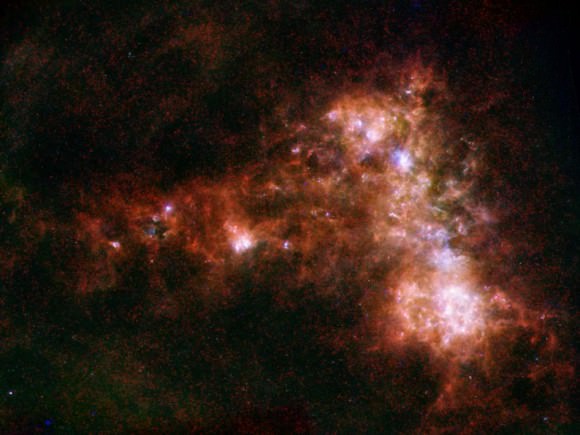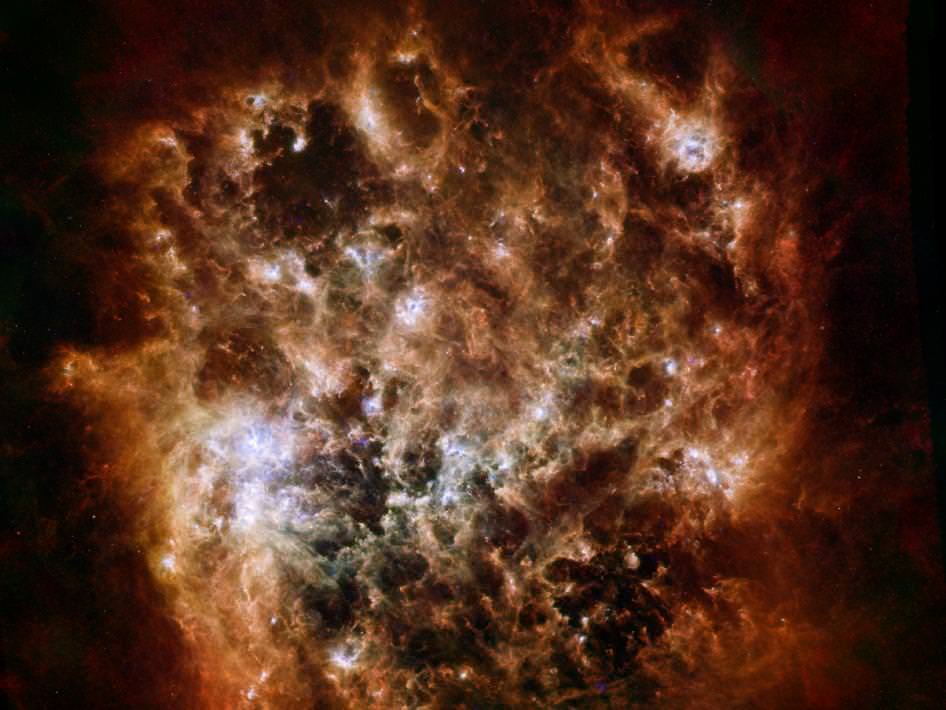[/caption]
When we think of stars, we might think of their building blocks as white hot… But that’s not particularly the case.The very “stuff” that creates a sun is cold dust and in this combined image produced by the Herschel Space Observatory, a European Space Agency-led mission with important NASA contributions; and NASA’s Spitzer Space Telescope, we’re taking an even more incredible look into the environment which forms stars. This new image peers into the dusty arena of both the Large and Small Magellanic Clouds – just two of our galactic neighbors.
Through the infra-red eyes of the Herschel-Spitzer observation, the Large Magellanic Cloud would almost appear to look like a gigantic fireball. Here light-years long bands of dust permeate the galaxy with blazing fields of star formation seen in the center, center-left and top right (the brightest center-left region is called 30 Doradus, or the Tarantula Nebula. The Small Magellanic Cloud is much more disturbed looking. Here we see a huge filament of dust to the left – known as the galaxy’s “wing” – and, to the right, a deep bar of star formation.

What makes these images very unique is that they are indicators of temperature within the Magellanic Clouds. The cool, red areas are where star formation has ceased or is at its earliest stages. Warm areas are indicative of new stars blooming to life and heating the dust around them. “Coolest areas and objects appear in red, corresponding to infrared light taken up by Herschel’s Spectral and Photometric Imaging Receiver at 250 microns, or millionths of a meter. Herschel’s Photodetector Array Camera and Spectrometer fills out the mid-temperature bands, shown in green, at 100 and 160 microns.” says the research team. “The warmest spots appear in blue, courtesy of 24- and 70-micron data from Spitzer.”
Both the LMC and SMC are the two largest satellite galaxies of the Milky Way and are cataloged as dwarf galaxies. While they are large in their own right, this pair contains fewer essential star-forming elements such as hydrogen and helium – slowing the rate of star growth. Although star formation is generally considered to have reached its apex some 10 billion years ago, some galaxies were left with less basic materials than others.
“Studying these galaxies offers us the best opportunity to study star formation outside of the Milky Way,” said Margaret Meixner, an astronomer at the Space Telescope Science Institute, Baltimore, Md., and principal investigator for the mapping project. “Star formation affects the evolution of galaxies, so we hope understanding the story of these stars will answer questions about galactic life cycles.”
Original Story Source: NASA/Herschel News.

